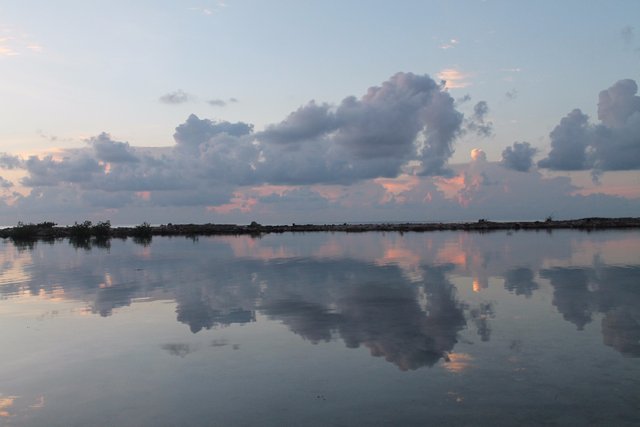Getting Down With the Sea: Part 1

It is so vast.
Bigger than you could ever expect. To your eyes it feels so empty, but you can feel that there is so much more underneath you.
Some of the ecosystem is behind the Belize Barrier Reef, but there are also atolls on the open ocean. We got to see the open ocean side from a not so sea-ready sailboat.
Out in open ocean, between 40 and 60 km from the coast, and on top of thousands of meters of water, mother nature is the ruler.
The sea has its way with a 34 foot sailboat, and storms that brew up are so powerful and turn the sea so wild that it makes us feel so irrelevant.
Seeing the barrier reef from the ocean was completely, and utterly mentally, emotionally and physically taxing.
But the open ocean has an immense beauty to it as well.
Dolphins racing the sailboat, skies of all the colours and shapes, ocean hues that change from a deep sapphire to a bright emerald.
For us being at sea was survival, both physically in our actions but also in both our mental and emotional states. It was a very un-grounding experience.
Cayes appeared, like oasis mirages in our desert of salt water.
LAND!!!!!
The thing that makes us feel safe.
The cayes that surround and are part of the reef and atolls are home to tourism, and employment of a small number of locals.
If you see a local who calls one of the cayes their home, it is an exception rather than the rule. (The few we met who live on Tobacco Caye are soon to be pushed out for more tourist accommodations.)
To the locals the reef is money, only having rules appear about its use in 1992 when it became protected marine reserves.
The locals fish as much as they can, as fast as they can. Conch season opened October 1st, and we were treated to the sights of opening season. Fishermen quadruple the island's population during the day, leaving behind the mountains of empty conch shells, broken open like a piggy bank.
The flurry of activity lasts 2-3 days. The fisherman stay on the caye or return to the mainland, drink away their money, and then a day or two later return and fish as furiously as when the season opened.
To us, it seems that many of the local people do not understand, are not educated about or simply don’t care about the magnificent ecosystem that lies below.
A marine biologist we met on tobacco caye, had a classroom of children from the mainland out to educate them on the reef, a program that recently started. With the intention that if they came to see it, they can learn to appreciate and respect the reef.
While the Belize government has its conservation efforts, it seems that most other conservation or eco-consciousness comes from outside the country.
When the Swedish owner bought Reef’s End Lodge on Tobacco Caye in 2014 from a local Belizean, he did a massive overhaul to more sustainably produce power, collect and store water, and recycle, though there is little to no infrastructure for it in the country. He even takes dead batteries in his luggage back to Sweden to be recycled.
Land was an incredible change in pace and thinking for us as we were right next to the dangerously beautiful ocean. But having our comforts and conveniences on land let us interact with it more, and be more analytical of what we had experienced and were now seeing.
From the land we got to interact with the ocean at our own will, and holy is she pretty!!!
Snorkelling out and around the Belize Barrier Reef and Glover's Atoll is remarkable. Places teeming with huge fish, colourful fish, and all the things not fish…but all the while feeling like you’re in a magical wet dream world.
Scuba diving down and seeing all the sea life like from snorkelling, but more. Ian’s first time, hanging out with a massive sea turtle for 5 minutes, calmly swimming around its domain.
The monstrous coral structures at both places were incredible. And there may be no feeling in the world quite like going over a beautiful reef, and into the blue abyss that is thousands of meters of open ocean. Being able to hover in that still water, on the edge of the abyss is something neither of us will forget.
For as much tourism is there, overfishing is there, and other problems that are there. Experiencing these reefs being in the water, how can you not call this area wild?
Land, the thing that makes us feel safe. Is it a social construct? Do the comforts and conveniences we have on land allow us to experience the water in a completely different way? Those same crazy forces that caused us stress while on the sailboat, were still there while we are on land. So powerful that they change the islands and the structure of the reef, but we are much more comfortable seeing these forces from a hammock.
No policies can control what Mother Nature has planned for this area. We can’t even begin to explore this incredible place without devices that allow us to breathe underwater. We can have our human influences on the land that is there, and although we can impact what happens under the surface, we truly have no control over this wild place.
Video to follow in Part 2.
Special thanks to Reefs End Lodge & Glover's Reef Atoll Resort, providing fantastic accommodation and experiences for us.
Love Always,
Amber-Leigh & Ian
Wonderful description of the power and beauty of the sea. Belize is a part of the world I have always wanted to visit, I really enjoyed reading your post and story.
Thanks so much! It truly is an incredible place, and one you should try to make it to one day.